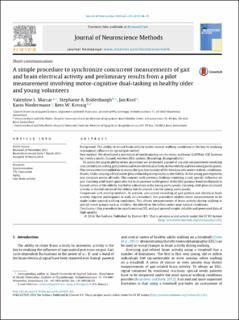Please use this identifier to cite or link to this item:
https://doi.org/10.21256/zhaw-3815Full metadata record
| DC Field | Value | Language |
|---|---|---|
| dc.contributor.author | Marcar, Valentine Leslie | - |
| dc.contributor.author | Bridenbaugh, Stephanie A. | - |
| dc.contributor.author | Kool, Jan | - |
| dc.contributor.author | Niedermann Schneider, Karin | - |
| dc.contributor.author | Kressig, Reto W. | - |
| dc.date.accessioned | 2018-06-29T10:15:53Z | - |
| dc.date.available | 2018-06-29T10:15:53Z | - |
| dc.date.issued | 2014 | - |
| dc.identifier.issn | 0165-0270 | de_CH |
| dc.identifier.uri | https://digitalcollection.zhaw.ch/handle/11475/7511 | - |
| dc.description.abstract | Background: The ability to record brain activity under normal walking conditions is the key to studying supraspinal influence on spinal gait control. New method: We developed a procedure of synchronizing an electronic walkway (GAITRite, CIR Systems Inc.) with a multi-channel, wireless EEG-system (BrainAmp, Brainproducts). To assess the practicability of our procedure we performed a proof of concept measurement involving concurrently recording gait pattern and brain electrical activity in two elderly and two young participants. This measurement enabled us to assess the synchronization of the two data sets under realistic conditions. Results: Only carrying a filled water glass reduced gait regularity in the elderly. In the young gait regularity was constant across all tasks. This concurs with previous findings reporting a task specific influence on gait. Carrying a full water glass also led to an increase in the power of the EEG gamma-band oscillations in frontal cortex of the elderly, but led to a decrease in the young participants. Carrying a full glass increased activity in frontal cortex of the elderly but decreased it in the young participants. Comparison with existing methods: At present, concurrent recording of gait pattern and electrical brain activity requires participants to walk on a treadmill. Our procedure enables these measurements to be made under natural walking conditions. This allows measurements of brain activity during walking in special needs groups such as children, the elderly or the infirm under near natural conditions. Conclusions: Our procedure for synchronizing EEG and gait proved simple, reliable and generated data of high-quality. | de_CH |
| dc.language.iso | en | de_CH |
| dc.publisher | Elsevier | de_CH |
| dc.relation.ispartof | Journal of Neuroscience Methods | de_CH |
| dc.rights | http://creativecommons.org/licenses/by/3.0/ | de_CH |
| dc.subject | Brain Activity | de_CH |
| dc.subject | Synchronization | de_CH |
| dc.subject | Gait | de_CH |
| dc.subject | Concurrent Aging | de_CH |
| dc.subject.ddc | 610: Medizin und Gesundheit | de_CH |
| dc.title | A simple procedure to synchronize concurrent measurements of gait and brain electrical activity and preliminary results from a pilot measurement involving motor-cognitive dual-tasking in healthy older and young volunteers | de_CH |
| dc.type | Beitrag in wissenschaftlicher Zeitschrift | de_CH |
| dcterms.type | Text | de_CH |
| zhaw.departement | Gesundheit | de_CH |
| zhaw.organisationalunit | Institut für Physiotherapie (IPT) | de_CH |
| dc.identifier.doi | 10.21256/zhaw-3815 | - |
| dc.identifier.doi | 10.1016/j.jneumeth.2014.03.003 | de_CH |
| zhaw.funding.eu | No | de_CH |
| zhaw.originated.zhaw | Yes | de_CH |
| zhaw.pages.end | 49 | de_CH |
| zhaw.pages.start | 46 | de_CH |
| zhaw.publication.status | publishedVersion | de_CH |
| zhaw.volume | 228 | de_CH |
| zhaw.publication.review | Peer review (Publikation) | de_CH |
| Appears in collections: | Publikationen Gesundheit | |
Files in This Item:
| File | Description | Size | Format | |
|---|---|---|---|---|
| 2014_Nika_A_simple_procedure_to_synchronize.pdf | 440.75 kB | Adobe PDF |  View/Open |
Show simple item record
Marcar, V. L., Bridenbaugh, S. A., Kool, J., Niedermann Schneider, K., & Kressig, R. W. (2014). A simple procedure to synchronize concurrent measurements of gait and brain electrical activity and preliminary results from a pilot measurement involving motor-cognitive dual-tasking in healthy older and young volunteers. Journal of Neuroscience Methods, 228, 46–49. https://doi.org/10.21256/zhaw-3815
Marcar, V.L. et al. (2014) ‘A simple procedure to synchronize concurrent measurements of gait and brain electrical activity and preliminary results from a pilot measurement involving motor-cognitive dual-tasking in healthy older and young volunteers’, Journal of Neuroscience Methods, 228, pp. 46–49. Available at: https://doi.org/10.21256/zhaw-3815.
V. L. Marcar, S. A. Bridenbaugh, J. Kool, K. Niedermann Schneider, and R. W. Kressig, “A simple procedure to synchronize concurrent measurements of gait and brain electrical activity and preliminary results from a pilot measurement involving motor-cognitive dual-tasking in healthy older and young volunteers,” Journal of Neuroscience Methods, vol. 228, pp. 46–49, 2014, doi: 10.21256/zhaw-3815.
MARCAR, Valentine Leslie, Stephanie A. BRIDENBAUGH, Jan KOOL, Karin NIEDERMANN SCHNEIDER und Reto W. KRESSIG, 2014. A simple procedure to synchronize concurrent measurements of gait and brain electrical activity and preliminary results from a pilot measurement involving motor-cognitive dual-tasking in healthy older and young volunteers. Journal of Neuroscience Methods. 2014. Bd. 228, S. 46–49. DOI 10.21256/zhaw-3815
Marcar, Valentine Leslie, Stephanie A. Bridenbaugh, Jan Kool, Karin Niedermann Schneider, and Reto W. Kressig. 2014. “A Simple Procedure to Synchronize Concurrent Measurements of Gait and Brain Electrical Activity and Preliminary Results from a Pilot Measurement Involving Motor-Cognitive Dual-Tasking in Healthy Older and Young Volunteers.” Journal of Neuroscience Methods 228: 46–49. https://doi.org/10.21256/zhaw-3815.
Marcar, Valentine Leslie, et al. “A Simple Procedure to Synchronize Concurrent Measurements of Gait and Brain Electrical Activity and Preliminary Results from a Pilot Measurement Involving Motor-Cognitive Dual-Tasking in Healthy Older and Young Volunteers.” Journal of Neuroscience Methods, vol. 228, 2014, pp. 46–49, https://doi.org/10.21256/zhaw-3815.
Items in DSpace are protected by copyright, with all rights reserved, unless otherwise indicated.